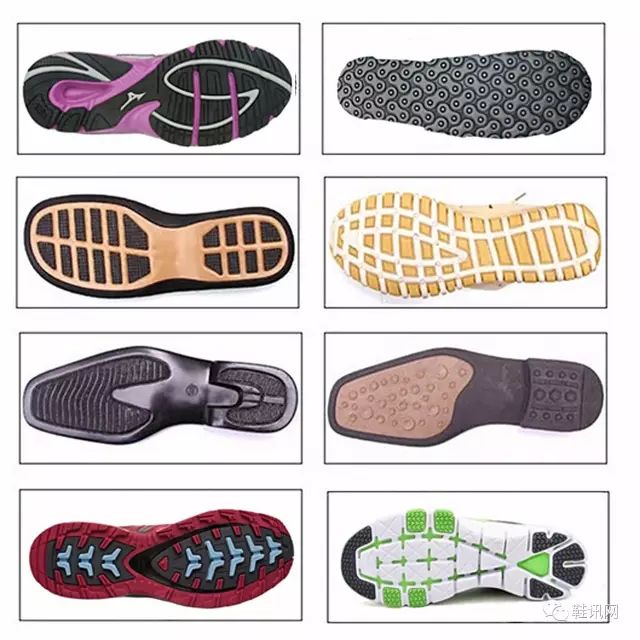Complete knowledge of shoe soles(2)
Reading times:704 Update time:2023-05-17
12. Imitation leather sole:
It is a typical rubber plastic material with high elasticity, mainly composed of rubber as the base material, and added with 10% -30% high styrene to imitate the performance of leather soles. The appearance is similar to natural sole leather, with grain patterns, and the products made from it are lightweight and have clear lines; When worn, it is light and comfortable, and there is no noise, slip resistance, and wear resistance. This type of sole not only has good elasticity, but also has high hardness and rigidity, and its performance is similar to natural leather. Although it does not have the breathability and moisture absorption properties of natural leather, it also has the advantage of not being afraid of water.
13.BPU:
It is a new type of modified polyurethane (PU), which has the advantages of environmental protection, low density (ultra light weight), thick surface crust (smooth surface), good toughness, not easy to fracture, and good weather resistance. It can replace EVA outsole, EVA waterproof platform, blow blown PVC platform, wooden shoes, PVC foam platform, etc.
This modified polyurethane wood like material is very lightweight, with beautiful wood grain, temperature resistance, and adjustable degradation period, making it a green and environmentally friendly new material.
14. Beef tendon (Tianjin) bottom:
Thermoplasticalastomer bottom, a light yellow translucent sole named after its color and appearance resembling cow hooves Cow tendon sole "refers to a type of rubber sole that is as strong as cow tendon, but is artificially made, also known as a thermoplastic elastic rubber sole. (Initially, it started with rubber cow's tendon, which was mainly used to connect this color with other materials after making sandals. It can be said that cow's tendon initially referred to natural rubber, and later evolved into a color card.)
The bottom of the cow tendon can be made of rubber or plastic, with thermoplastic rubber (TPR) being the most convenient. This type of sole has a beautiful appearance, good elasticity and wear resistance, comfortable to wear, and is silent when walking. It is a good sole material for travel shoes and daily shoes.
Rubber tendon: Over time, it will turn white with a layer of misty secretion on the surface; Cut a small amount with a blade and ignite it with fire to form a black gray residue with a small amount of white solid. It is difficult to see dripping during combustion, and there is a foul smell of rubber with a small amount of black smoke. (With the development of technology, some rubber cow tendon misty secretions may not appear.)
TPR beef tendon: Cut a small amount with a knife and ignite it with fire. When burning, there is black smoke mixed with a small amount of gray green, a dripping phenomenon, a sticky odor, and the burning time is slightly faster than that of rubber beef tendon. There is a small amount of black burnt solid residue.
15. Midea Bottom:
Meinai sole (also known as Laiban, Laiduo stick, and rubber imitation leather sole) is actually a rubber sole, but with different processing methods. Compared to Meinaidi, it is cheaper.
The main component of the Meinai sole is rubber, which is fine in texture, wear-resistant, and resistant to twists and turns. It is infinitely extended, usually 1 meter wide, and cut into 2 meters long after coming out of the rolling press. It needs to be punched with a punching knife, then polished and colored, with a thickness generally between 3-5mm, depending on the needs.
16. ABS Bottom:
AcrylonitrileButadiene Styrene, a copolymer of acrylonitrile butadiene styrene.
ABS engineering plastics are generally opaque, light ivory in appearance, non-toxic, tasteless, and both tough, hard, and rigid. They burn slowly, with yellow flame and black smoke. After burning, the plastics soften and scorch, giving off a special smell of cinnamon, but there is no melting and dripping phenomenon.
It has excellent comprehensive performance, excellent impact strength, good dimensional stability, electrical properties, wear resistance, chemical resistance, dyeing resistance, and good molding and mechanical processing. Disadvantages: Low thermal deformation temperature, flammable, and poor weather resistance.
17. PE bottom:
PE plastic (polyethylene), English name: Polyester. Excellent corrosion resistance, electrical insulation (especially high-frequency insulation), high rigidity, hardness and strength, low water absorption, good electrical performance and radiation resistance.
The PE bottom has good softness, elongation, impact strength, and permeability; Good fatigue resistance, wear resistance, and corrosion resistance.
18. SBR Bottom:
Styrene butadiene rubber is a polymer elastomer material synthesized through copolymerization reaction with butadiene and styrene as the main monomers, with uniform and pure quality and minimal impurities. Soluble in organic solvents such as benzene, toluene, gasoline, chloroform, etc. The unsaturated double bond in the SBR molecule and the curing agent form a cross-linked network structure through substitution or addition reaction. The SBR vulcanizate reinforced by the reinforcing agent has higher physical and mechanical properties.
Styrene butadiene rubber has a slow vulcanization speed, but has good vulcanization flatness and is not prone to over vulcanization. It has excellent properties such as aging resistance, heat resistance, and wear resistance.
19. PP Bottom:
PP plastic (polypropylene), English name: Polypropylene. It is a high-density, side chain free, high crystalline linear polymer with excellent comprehensive properties. When not colored, it appears white, translucent, and waxy; Lighter than polyethylene. The transparency is also better than polyethylene, and it is harder than polyethylene.
PP sole has low density, excellent strength, stiffness, hardness, and heat resistance; It has good electrical performance and high-frequency insulation, is not affected by humidity, and is corrosion-resistant. But it becomes brittle at low temperatures, is not wear-resistant, is prone to aging, and is prone to decomposition under specific conditions.

